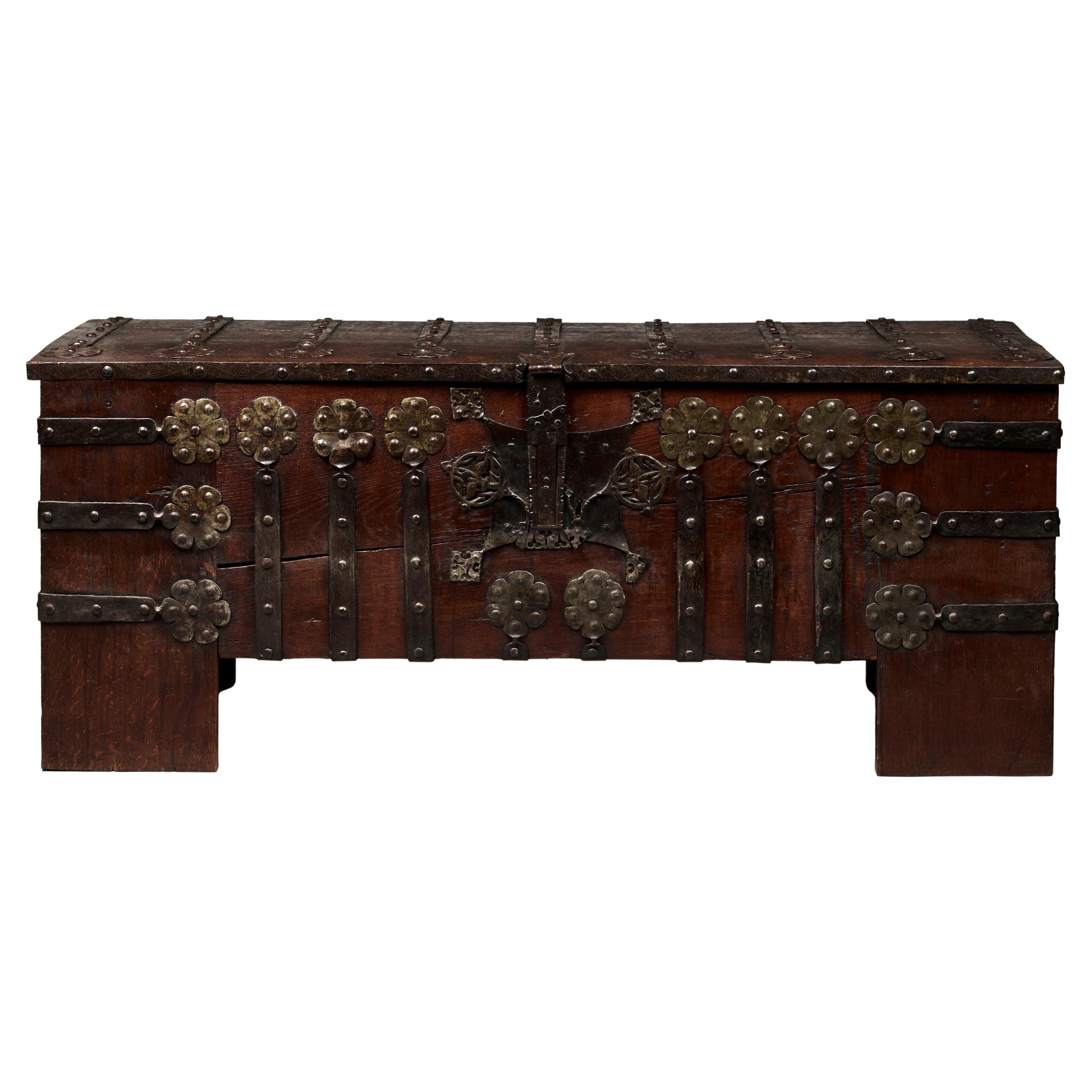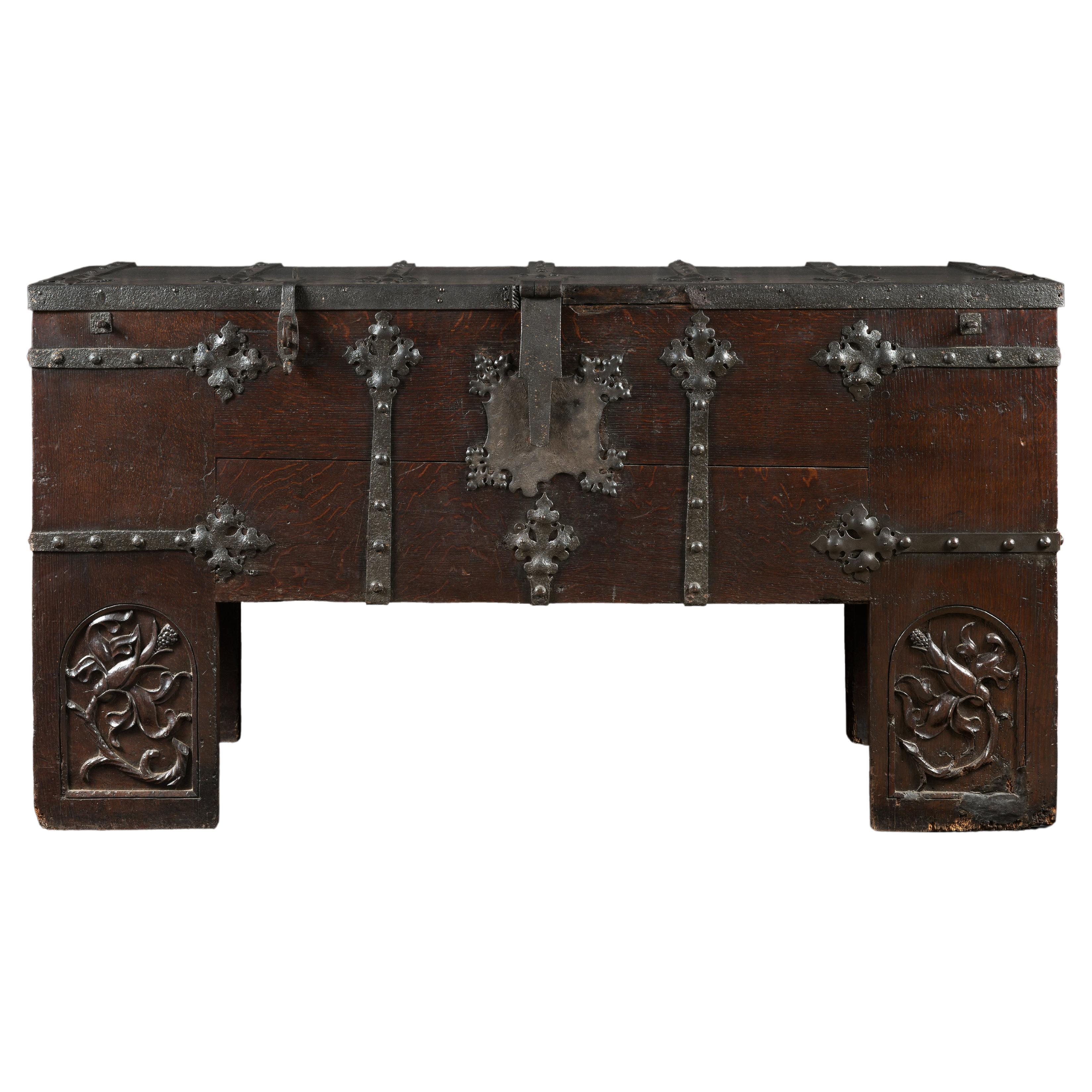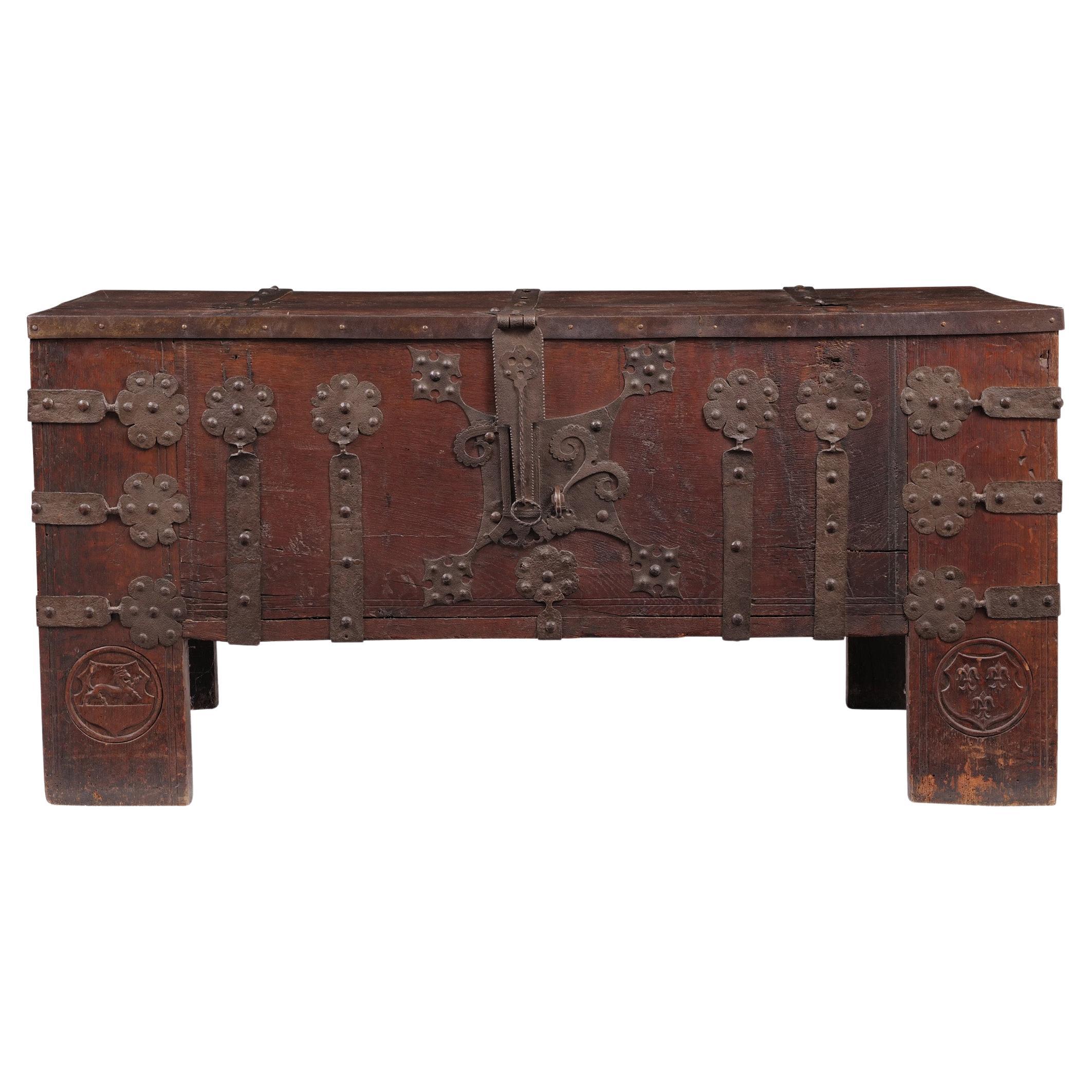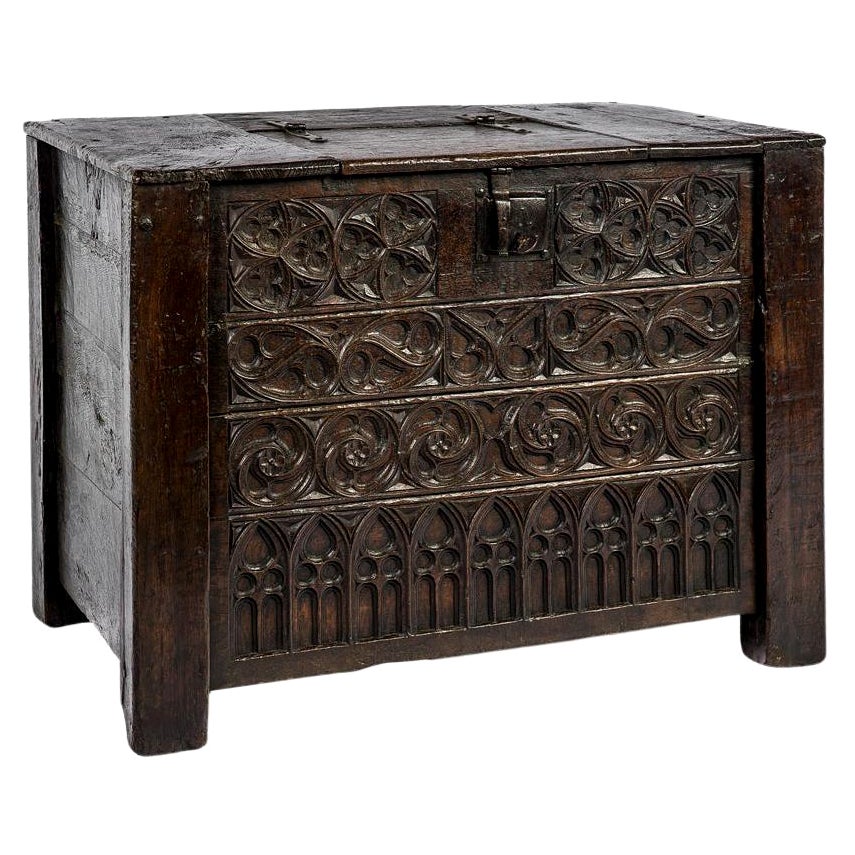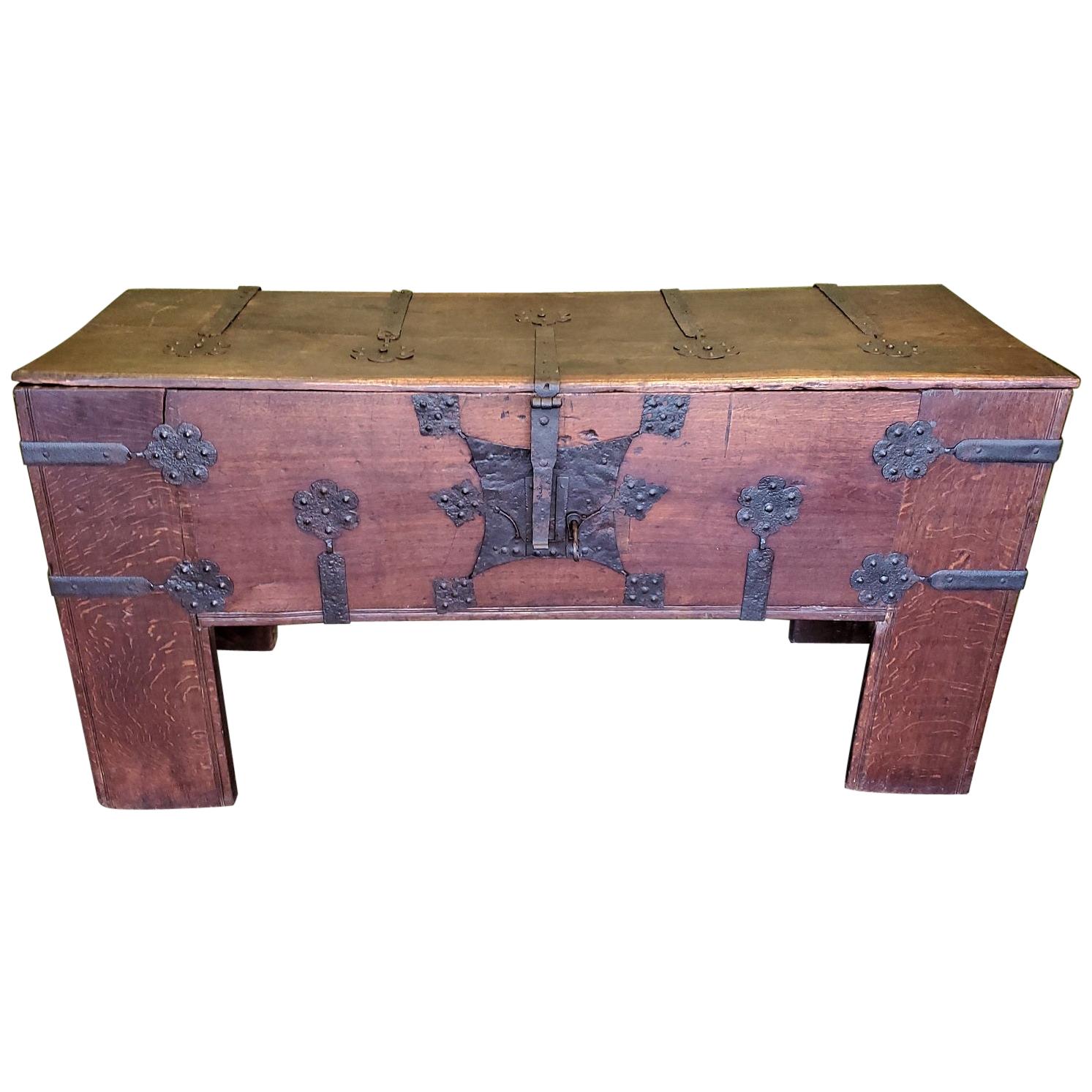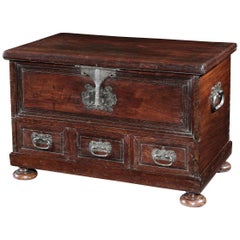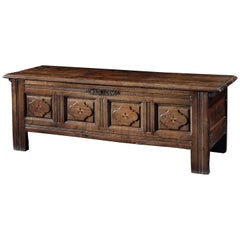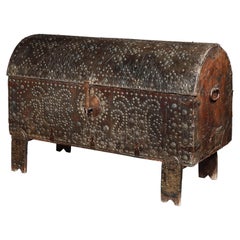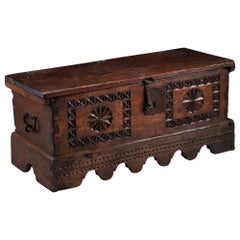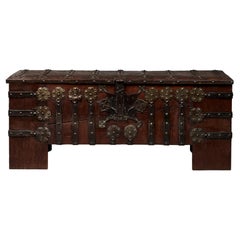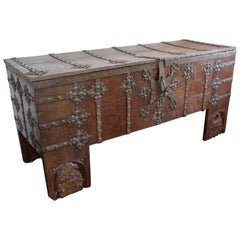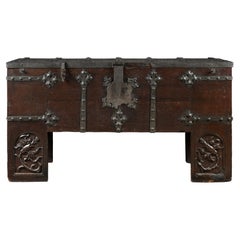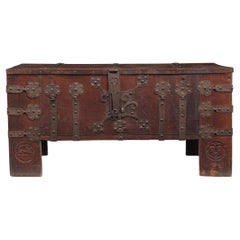Items Similar to Chest or Stollentruhe, Early 16th Century, German Gothic, Oak Chest, Original
Want more images or videos?
Request additional images or videos from the seller
1 of 15
Chest or Stollentruhe, Early 16th Century, German Gothic, Oak Chest, Original
$34,242.53
£25,000
€29,384.64
CA$47,276.43
A$52,412.92
CHF 27,545.03
MX$641,448.13
NOK 344,009.45
SEK 322,887.29
DKK 219,338.12
About the Item
This standing chest is of clamp-front construction, extensively decorated with long, ironwork straps with quatrefoil finials which ‘wrap’ around it, and has an ornate, central lockplate, and front legs with full, height stiles. The ironwork straps and finials are fixed with convex, headed nails: running along the front, five long straps; the two side straps; and the five straps on the top. On the chest front, centrally placed, is a large, iron lockplate with four outer, radiating spade finals in each corner and three, superimposed spade finials (a symbol of nobility) which are pierced with the initials ‘BB’. The lockplate receives a corresponding, external hasp fitted to the lid. Below the floor of the chest, the two front stile legs retain most of their original height. The lid is supported by substantial iron strap hinges that extend right down the back of the chest. Inside the chest at the left end is a shallow, oak till.
Construction The chest is of joined, 'clamp-front' construction, reinforced by the nailed, iron mounts. In total it uses ten, oak boards which were riven and planed. The back and front are each formed from a large single plank held to the full height stiles by long, pegged tenons. The sides are also single boards joined into the stiles using long tenons held by dowels, and extend down below the chest bottom, concealing the ends of the bottom boards. The bottom consists of a single board cut into the sides and shallow rebates in the stiles. The front and back boards are dowelled into the bottom boards. The lid which overhangs the sides has a narrow cleat at each end, and consists of one wide plank which has bowed a little as a result of shrinkage.
Ironwork : The wrought ironwork straps, lockplate, hasp and lock all appear all appear to be early, and of the same original manufacture and are fixed with convex headed nails. There is mild dark staining of the oak around the iron mounts, possibly because of low tannin content in the oak.
Length 172 cm., 67 ¾ in., Height 71.5 cm., 28 ¼ in., Depth 63 cm., 24 ¾ in.,
Related to: No 900:2-1904 V&A Museum, London. Stadtmuseum Dusseldorf. Decorative Arts Museum Berlin. Museen Schleswig-Holstein & Hamburg. A related example featuring elaborately-carved feet and formerly in the Horsham Museum, West Sussex, sold at Christie's in 2010 for £97,250 and another example, again with carved feet sold at Sothebys in 2006 for £48,000.
Literature: A similar example is illustrated in H. Lüttgens, Alt- Aachener Wohnkultur; Ein Rundgang durch ein altes Aachener Haus im Wohnstil des 18. Jahrhunderts, Aachen, n.d., ill. 12, and another comparable iron-bound chests illustrated in H. Kreisel, Die Kunst des Deutschen Möbels, Munich, 1974, pls. 45-46.
This type of large oak standing chest is known as a 'stollentruhe' (studded chest) and is thought to have been made from at least the early-16th century, based on the style of ironwork and form of the front legs which tend to be carved on earlier models. The German Renaissance was established and Albrecht Dürer and Lucas Cranach the elder were famous throughout Europe. The type has become closely associated with the Westphalia region in central, western Germany (between the Rhine and Weser rivers, located north and south of the Ruhr River).
The great weight of this chest, the plain back, and decorative carving and ironwork indicative that it was essentially a static piece of furniture, combining large storage capacity and a reasonable measure of security with conspicuous display. In addition to its impressive proportions and height off the ground (keeping the contents away from damp or dirty floors), its most showy aspect is the wrought and cut ironwork mounts. The multiple, iron straps fulfil a Dual role: decorative but also reinforcing the structural wood joints. Evidently such chests were intended to be secure: the timbers and hinges (a notorious weakpoint of chests) are notably robust. The central lock-plates on these chests are particularly impressive but in terms of security represent the weak point of the chest. Geoff Egan has described medieval locks as ‘among the most complex everyday objects to have survived, although most have simple, easily-picked mechanisms, inside cases designed to look as robust and secure as possible’ (Egan, Late Gothic 1998). In the same way as keys were displayed as a badge of status by officers of the household and women in Renaissance Europe, ornate locks on doors and chests were part of a concern to draw attention to household wealth and its distribution on controlled terms. Whatever the contents of such chests, they were a way to assert the authority of the owner. The pierced initials ‘BB’ indicate that this was made for a particular person and the use of the spade motif on the central part of the lockplate suggests that he or she was of noble status.
Function : Chests (of all shapes and sizes) were the most common form of furniture in late-medieval/Renaissance households. Even poor households are likely to have had at least one, while the inventories of great households can list hundreds. They were used to hold all manner of goods: coin, plate and personal jewels, clothes and textiles, vestments and chapel ornaments, muniments, books, arms and armour, lights, grain and bread. A practical disadvantage of large chests was accessing contents especially smaller objects at the bottom. Most chests of any quality have a built-in, lidded compartment or 'till' across one or both ends. These must have been convenient for smaller valuables (and perhaps candles), and some were fitted with their own lock. Chests were conventionally placed next to beds. They often contained valuable linen for the bed, but would also be close under the watchful eye of the owner.
- Dimensions:Height: 28.15 in (71.5 cm)Width: 67.72 in (172 cm)Depth: 24.81 in (63 cm)
- Style:Gothic (Of the Period)
- Materials and Techniques:Oak,Metalwork
- Place of Origin:
- Period:
- Date of Manufacture:1500-1559
- Condition:Wear consistent with age and use.
- Seller Location:BUNGAY, GB
- Reference Number:1stDibs: LU3867315797382
About the Seller
5.0
Vetted Professional Seller
Every seller passes strict standards for authenticity and reliability
Established in 1985
1stDibs seller since 2018
99 sales on 1stDibs
Typical response time: 9 hours
- ShippingRetrieving quote...Shipping from: BUNGAY, United Kingdom
- Return Policy
Authenticity Guarantee
In the unlikely event there’s an issue with an item’s authenticity, contact us within 1 year for a full refund. DetailsMoney-Back Guarantee
If your item is not as described, is damaged in transit, or does not arrive, contact us within 7 days for a full refund. Details24-Hour Cancellation
You have a 24-hour grace period in which to reconsider your purchase, with no questions asked.Vetted Professional Sellers
Our world-class sellers must adhere to strict standards for service and quality, maintaining the integrity of our listings.Price-Match Guarantee
If you find that a seller listed the same item for a lower price elsewhere, we’ll match it.Trusted Global Delivery
Our best-in-class carrier network provides specialized shipping options worldwide, including custom delivery.More From This Seller
View AllChest, Cassone, 17th Century, Portuguese, Baroque, Brazil, Hardwood
Located in BUNGAY, SUFFOLK
This striking chest is made from a Brazilian hardwood which I have not been able to identify. The color and figuring of the timber together with the Classic form and ornamentation su...
Category
Antique Late 17th Century Portuguese Baroque Blanket Chests
Materials
Hardwood
Chest, Coffer, 17 Century, German, Baroque, Oak, Marquetry, Inlay, 30 cubic feet
Located in BUNGAY, SUFFOLK
This vernacular chest exudes character and charm. The moulded panels and inlay inject gravitas. It has a lovely mellow lustrous patina. It is unusual being large and providing a copi...
Category
Antique Early 17th Century German Baroque Blanket Chests
Materials
Oak
Arcon, Chest, Coffer, Leather, Spanish, Baroque, Brass Studwork, Domed, Travel
Located in BUNGAY, SUFFOLK
Exceptional, early 17th century, Spanish, leather, ‘Arcon’ or domed travelling coffer ornamented with brass studwork
Surviving utalitarian pieces such as travelling coffers from t...
Category
Antique 1620s Spanish Baroque Blanket Chests
Materials
Leather
Chest Coffer Spanish Chip Carved Folk 18th Century Pine Ironwork Small 3ft long
Located in BUNGAY, SUFFOLK
- Rare small size, would work as a sofa or low table with the advantage of storage space
- Characterful chip carving, ironwork and figuring injecting atmosphere into any interior
- W...
Category
Antique 1720s Spanish Baroque Blanket Chests
Materials
Pine
Cassone, Chest, Coffer, 17th Century, French, Louis XIV, Walnut
Located in BUNGAY, SUFFOLK
Lovely cassone with classical form, the beautiful figuring of the oak creates subtle, decorative patterning and the simple mouldings give a light, contemporary feel.
The rich, lustr...
Category
Antique Late 17th Century French Louis XIV Blanket Chests
Materials
Walnut
Cassone, 17th Century, Italian, Baroque, Vernacular, Walnut, Carved, Hearts
Located in BUNGAY, SUFFOLK
This handsome cassone has ornament with romantic associations and was most likely a marriage chest. It is a good example of the Italian vernacular, simple in a sophisticated manner. ...
Category
Antique Late 17th Century Italian Baroque Blanket Chests
Materials
Walnut
You May Also Like
Rare Gothic German Oak and Iron Chest Known as "Stollentruhe" 16th century
Located in Worpswede / Bremen, DE
The large rectangular standing chest on stile feet, extensively mounted with wrought ironwork straps with stylised sixfoil motif. These are fixed with convex head nails: running vert...
Category
Antique 16th Century German Gothic Blanket Chests
Materials
Iron
Rare Late Medieval 16th Century German Wrought Iron Oak Chest or Stollentruhe
Located in Worpswede / Bremen, DE
A very impressive Westphalian Gothic chest or ‚Stollentruhe’, Westphalia, Germany, circa 1500-1550. Wrought iron mounted oak, partially carved. The monumental rectangular standing chest with full-height stiles, extensively mounted with wrought ironwork straps terminating in quatrefoil finials which ’wrap’ around the chest edges. These are fixed with convex head nails. The ironwork with some remains of an originally red painted surface. In addition, running along the edges of the lid at the front and sides is a plain iron band, close-nailed. The feet of the two front legs are finely carved on the front face, in low relief with a rectangular arched ’panel’ depicting on the left a lion, on the right a dragon holding each a coat of arms.
Regarding the age of circa 500 years, this coffer is in exceptionally good condition, with only smaller restorations.
Comparative literature
• Baumeier, Stefan, Beschlagene Kisten; Die ältesten Truhen Westfalens, Essen, 2012.
• Falke, Otto von, Deutsche Möbel...
Category
Antique 16th Century German Medieval Blanket Chests
Materials
Iron
Rare Gothic German Oak and Iron Chest Known as "Stollentruhe"
Located in Saint-Ouen, FR
This large chest stands on high legs prolonging the lateral jambs. Presenting a sober and severe appearance the chest still belongs to the Medieval tradition. The piece is made from very high quality Hungarian wood.
The jambs are joined to the facade and the lateral sides thanks to pegged mortise and tenon securing a great stability and squareness between each parts. The upper lid is made of two joined parts and so is the facade.
The ironwork is present all over the surface of the chest and brings both an additional stability to the construction as well as a rich decor. The lid is secured with hinges. Hinges also run all over the chest in horizontal and vertical lines, ending in a floral motif. The hasp lock is also very ornamental.
Those chests always present important proportions especially when they are made early in the period. This model was very popular in Germany and stayed in vogue until the 16th century. However the feet Gothic decor...
Category
Antique 15th Century and Earlier German Gothic Blanket Chests
Materials
Wrought Iron
Gothic front gallery chest, Westphalia around 1500 - 1550, oak
Located in Münster, DE
Gothic front gallery chest, Westphalia around 1500 - 1550, wrought iron bands, boxy oak body, partially carved. Monumental star-shaped key plate with original key, feet on the front ...
Category
Antique 16th Century German Gothic Blanket Chests
Materials
Oak
$15,689 Sale Price
20% Off
Rare 15th Century Solid Oak Medieval Dutch Gothic Chest or Trunk
Located in Casteren, NL
A very rare chest that was completely made of solid oak from the Netherlands middle ages.
It is a joined chest with hand carved geometric gothic front panels. The ornaments used are typical Gothic ornaments such as trefoil, mouchette, and trace.
This diminutive chest was probably made in the 15th century Netherlands. It has the typical construction of very early European furniture as is also seen on the German Stollentruhe.
The chest has only a small lid with forged hinges...
Category
Antique 15th Century and Earlier Dutch Gothic Blanket Chests
Materials
Wrought Iron
$10,459 Sale Price
41% Off
Rare (Late Medieval) 16th Century German Wrought Iron Oak Chest or Stollentruhe
Located in Dallas, TX
WE HAVE THE PLEASURE TO PRESENT an Exceptionally Rare (Late Medieval) 16th Century German Wrought Iron Oak Chest or Stollentruhe.
This is an Early...
Category
Antique 16th Century German Gothic Blanket Chests
Materials
Wrought Iron
More Ways To Browse
Chest On Chest Or Highboy
Spanish Or Mexican Chest Or Trunk
Antique Chest On Chest Furniture
Chest With Legs
Antique Side Chest
Antique Chest With Legs
Chests With Keys
Grain Chest
Locking Chest
Chest Lock
German Renaissance
Antique Chest Lock
Chest With Two Doors
16th Century Plate
Antique Wood Joints
Antique European Chest
Antique Iron Chest
Antique Chest Hinges
